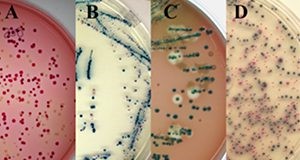Abstract
Shiga toxin is a protein found within the genome of a type of virus called a bacteriophage. These bacteriophages can integrate into the genomes of the bacterium E. Coli. Even though most E. coli are benign or even beneficial members of our gut microbial communities, strains carrying Shiga-toxin encoding genes are highly pathogenic in humans and other animals. This 6-page fact sheet discusses the two types of Shiga toxins and the best approaches to identifying and determining which Shiga toxin is present. Written by William J. Zaragoza, Max Teplitski, and Clifton K. Fagerquist, and published by the Department of Soil and Water Sciences, July 2016.
References
Blom, M., A. Meyer, P. Gerner-Smidt, K. Gaarslev, and F. Espersen. 1999. "Evaluation of Statens Serum Institut enteric medium for detection of enteric pathogens." J Clin Microbiol 37:2312-2316. https://doi.org/10.1128/JCM.37.7.2312-2316.1999
Bustin, S.A., V. Benes, J.A. Garson, J. Hellemans, J. Huggett, M. Kubista, R. Mueller, et al. 2009. "The MIQE guidelines: minimum information for publication of quantitative real-time PCR experiments." Clin Chem 55:611-22. https://doi.org/10.1373/clinchem.2008.112797
Church, D.L., D. Emshey, H. Semeniuk, T. Lloyd, and J.D. Pitout. 2007. "Evaluation of BBL CHROMagar O157 versus sorbitol-MacConkey medium for routine detection of Escherichia coli O157 in a centralized regional clinical microbiology laboratory." J Clin Microbiol 45:3098-3100. https://doi.org/10.1128/JCM.00426-07
Clotilde, L.M., A. Salvador, C. Bernard, A. Lin, C. Lauzon, M. Muldoon, Y. Xu, and J.M. Carter. 2015. "Comparison of multiplex immunochemical and molecular serotyping methods for shiga toxin-producing Escherichia coli." Foodborne Pathog Dis 12:118-21. https://doi.org/10.1089/fpd.2014.1827
Erickson, M.C., and M.P. Doyle. 2007. "Food as a vehicle for transmission of Shiga toxin-producing Escherichia coli." J Food Prot 70:2426-49. https://doi.org/10.4315/0362-028X-70.10.2426
Fagerquist, C.K., and W.J Zaragoza. 2016. "Bacteriophage cell lysis of Shiga toxin-producing Escherichia coli for top-down proteomic identification of Shiga toxins 1 & 2 using matrix-assisted laser desorption / ionization tandem time-of-flight mass spectrometry." Rapid Commun mass Spectrom 30:671-680. https://doi.org/10.1002/rcm.7507
Fagerquist, C.K., W.J. Zaragoza, O. Sultan, N. Woo, B. Quiñones, M.B. Cooley, R.E. Mandrell. 2014. "Top-down proteomic identification of Shiga toxin 2 subtypes from Shiga toxin-producing Escherichia coli by matrix-assisted laser desorption ionization-tandem time of flight mass spectrometry." Appl Environ Microbiol 80:2928-40. https://doi.org/10.1128/AEM.04058-13
Fagerquist, C.K., W.J. Zaragoza, O. Sultan, N. Woo, B. Quiñones, M.S. Swimley, M.B. Cooley, and R.E. Mandrell. 2013. "Top-down proteomic identification of Shiga toxin 2 variants from Shiga toxin-producing Escherichia coli (STEC) using MALDI-TOF-TOF-MS/MS-PSD6." 1st Conference on Mass Spectrometry and Allied Topics. https://doi.org/10.1155/2010/123460
Feng, P., S.D. Weagant, and K. Jinneman. 2011. "BAM: Diarrheagenic Escherichia coli." US Food Drug Adm.
Fuller, C.A., C.A. Pellino, M.J. Flagler, J.E. Strasser, and A. A. Weiss. 2011. "Shiga toxin subtypes display dramatic differences in potency." Infect Immun 79:1329-37. https://doi.org/10.1128/IAI.01182-10
Gould, L.H., C. Bopp, N. Strockbine, R. Atkinson, V. Baselski, B. Body, R. Carey, et al. 2009. "Recommendations for diagnosis of Shiga toxin-producing Escherichia coli infections by clinical laboratories." CDC Morb Mortal Wkly Rep.
He, X., Q. Kong, S. Patfield, C. Skinner, and R. Rasooly. 2016. "A new Immunoassay for detecting all subtypes of shiga toxins produced by Shiga toxin-producing E. coli in ground beef." PLoS One 11:e0148092. https://doi.org/10.1371/journal.pone.0148092
Leung, P., and J. Peiris. 2003. "A newly discovered verotoxin variant, VT2g, produced by bovine verocytotoxigenic Escherichia coli." Applied and Enviromental Microbiology 69:7549-7553. https://doi.org/10.1128/AEM.69.12.7549-7553.2003
Quiñones, B., S. Massey, M. Friedman, M.S. Swimley, and K. Teter. 2009. "Novel cell-based method to detect Shiga toxin 2 from Escherichia coli O157:H7 and inhibitors of toxin activity." Appl Environ Microbiol 75:1410-6. https://doi.org/10.1128/AEM.02230-08
Quiñones, B., and M.S. Swimley. 2011. "Use of a Vero cellbased fluorescent assay to assess relative toxicities of Shiga toxin 2 subtypes from Escherichia coli, p. 61-71." In Holst, O (ed.), Microbial Toxins. Humana Press, Totowa, NJ. https://doi.org/10.1007/978-1-61779-102-4_6
Scheutz, F., L.D. Teel, L. Beutin, D. Piérard, G. Buvens, H. Karch, A. Mellmann, et al. 2012. "Multicenter evaluation of a sequence-based protocol for subtyping Shiga toxins and standardizing Stx nomenclature." J Clin Microbiol 50:2951-63. https://doi.org/10.1128/JCM.00860-12
Schmidt, H., J. Scheef, S. Morabito, A. Caprioli, L.H. Wieler, and H. Karch. 2000. "A new Shiga toxin 2 variant (Stx2f) from Escherichia coli isolated from pigeons." Appl Environ Microbiol 66:1205-8. https://doi.org/10.1128/AEM.66.3.1205-1208.2000
Skinner, C., S. Patfield, B.J. Hernlem, and X. He. 2015. "New Stx2e monoclonal antibodies for immunological detection and distinction of Stx2 subtypes." PLoS One 10:e0132419. https://doi.org/10.1371/journal.pone.0132419
Stigi, K.A., J.K. Macdonald, A.A. Tellez-Marfin, and K.H. Lofy. 2012. "Laboratory practices and incidence of nonO157 shiga toxin-producing escherichia coli infections." Emerg Infect Dis 18:477-479. https://doi.org/10.3201/eid1803.111358
Teel, L.D., A.R. Melton-Celsa, C.K. Schmitt, and A.D.O. Brien. 2002. "One of two copies of the gene for the activatable Shiga toxin type 2d in Escherichia coli O91 : H21 strain B2F1 is associated with an inducible bacteriophage." Infect Immun. 70:4282-4291. https://doi.org/10.1128/IAI.70.8.4282-4291.2002
Wang, X., Y. Kim, Q. Ma, S.H. Hong, K. Pokusaeva, J.M. Sturino, and T.K. Wood. 2010. "Cryptic prophages help bacteria cope with adverse environments." Nat Commun 1:147. https://doi.org/10.1038/ncomms1146

